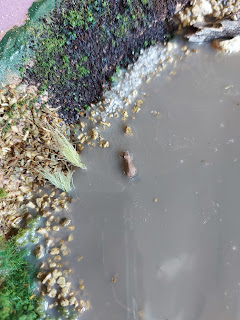FINISHED*
There were still ground to cover after the pond was poured.
First, the most fun of all...
...Saucy Intruders
It would be a Northern Ontario layout without:
Imported (!) from Europe via Nashville (thank you James).
 |
| Close up next to his lodge :) |
And another fella wandering a bit further in search of material for the lodge:
This is was all inspired by one of those amusing stories that kept us going during COVID about beavers stealing some lumber:
https://www.cbc.ca/news/canada/saskatchewan/porcupine-plain-beavers-stolen-posts-1.6023246
And there was still some scenery in the foreground to finish as well. The photos show the layer approach to build up the scene:
Nothing fancy, just a mixture of texture and colour. I added a few large boulders to keep cars out (they might try to go around the rusty gate) and tinted the gravel to keep it dusty.
I am a huge fan of that gate - the rust effects come from some paints I bought at Michaels for $10. The gate came out that way on the first try! Also my first soldering project.
And I used some powdered pastels to tone down the chalky white rocks and give them some more character. These rocks were originally from an "odor remover" bag that you stick in your closet to keeping your hanging clothes from getting musty!
...Oops, missed a spot
And I also went back and took care of the spot I never filled in by the station parking lot. I think my plan was to put a scene in showing a truck repair.
I had gone over a year without noticing the bare spot, which tells you how unobtrusive the gap was in the first place.
And man, the pick up truck is driving real slow!
And a repair:
When I built the unloading shed for Generic Canneries, I left it unattached to the building. This was deliberate in case I wanted to re-use the structure down the road. To keep the shed upright, I "hung" it against the building using a well-hidden piece of wood. I found that the shed slipped out of position. Also, the clearance wasn't there for regular sized boxcars.
So I pulled the shed out and added supports:
I hesitated over the repair for a while because I didn't know how long the supports needed to be or even how to measure. The aisle side supports were not a good guide since they were a bit higher.
I got very lucky...
Although it is hard to see from the photo, the clearance is much better now that the shed "stands" on its own five feet.
So...what's next?
I don't know :). There is always something to do, like write another post about what is next!
But for now I can say that I captured the image I had in my head in 2018...in fact the end result is even better!























































